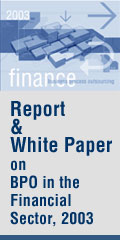|


|
Vast majority of banks lack enterprise-wide view of risk, says E&Y
December 17, 2008: Only 14% of respondents in a survey of top executives at nearly 40 global banks indicated they have a consolidated view of risk across their organizations. According to Ernst & Young’s second annual study on risk governance entitled Navigating the Crisis, the current economic crisis has exposed inherent weaknesses in risk management, forcing banks to improve their risk governance processes, increase the collaboration between risk and finance functions, and make instilling a risk culture a true priority.
Organizational silos, decentralization of resources and decision-making, inadequate forecasting, and lack of transparent reporting were cited as major barriers to effective enterprise-wide risk management. The need to create a risk-aware culture throughout the institution emerged as a top priority in the study – three-quarters of all respondents cited its vital importance – as banks struggle to develop a consolidated view of risk across business units and various risk dimensions.
“In light of recent events, there was strong agreement that managing risk effectively requires both top-down oversight and bottom-up involvement from front-line risk takers,” says Bill Schlich, leader of Ernst & Young’s Global Banking & Capital Markets practice. “In order to create and instill a culture of risk awareness within banks, risk management must become everyone’s business.”
To do that, respondents agreed that the discussion of risk must be elevated to the strategic level with much closer collaboration across functions, business units and risk classes. Eighty-six percent of those surveyed indicated that their banks are implementing a variety of projects designed to provide a more comprehensive approach to risk. However, only 16 percent said they have a well-defined, shared vision of what it would look like.
Respondents consistently cited the need for better information flow and reporting in the area of risk. Poor data quality, gaps in data flow, and the sheer volume of data are just a few challenges banks face. Sixty-seven percent of executives indicated that they were under way with the process of implementing consolidated risk reporting across their organizations but only 9% felt they have truly been able to aggregate data across the enterprise. Survey participants agreed greater transparency, faster delivery and better synthesis of data must be top priorities.
“In last year’s study, identifying emerging risk was reported to be a relatively low priority on the path to better risk management,” says Hank Prybylski, head of Ernst & Young’s Global Financial Services Risk Management practice. “The current crisis demonstrates the need for firms to focus on emerging and unforeseen risk.”
A vast majority of this year’s survey respondents said that their organizations do not have well-defined, rigorous processes for forecasting risk. However, all recognized the need to strengthen forecasting by developing more formal processes and more forward-looking risk assessment tools. This includes implementing more frequent executive risk committee meetings to monitor issues and events, creating detailed scenario modeling, and mandating periodic portfolio reviews to monitor leading risk indicators.
Many of those interviewed said this crisis might ultimately lead to more robust risk governance. The crisis is already acting as a catalyst by dismantling silos, promoting more dialogue between risk and finance, and stimulating broader discussion of risk as a core issue. As one executive observed, “The survivors of this 500-year flood will emerge as much stronger global institutions.”
(This is press release of Ernst & Young)
CLICK FOR SPECIAL SECTION ON GLOBAL FINANCIAL CRISIS
Outlooks on most banking systems in Asia Pacific turns negative
Greater refinancing risk for Asia-Pacific borrowers
Global real credit growth to halve this year
Government measures should stabilize global banking markets
Global banking industry to see more restructuring & consolidation
Indian Banking sector challenged by domestic, not global, factors
US Financial Crisis to indirectly impact Asian banks
Limited impact on Asia-Pacific banks from Lehman bankruptcy
Subprime Crisis: A Special
CLICK FOR MORE FEATURES & STORIES

|
|
|



